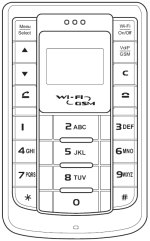Linux mobile phone does FMC
Feb 16, 2006 — by LinuxDevices Staff — from the LinuxDevices Archive — 4 views G-Tek has reportedly used Linux in a very basic, simple, dual-mode WiFi/quad-band GSM/GPRS phone that can provide Internet access to PCs and PDAs connected via USB or Bluetooth. The PWG500 can also provide “seamless roaming” between WiFi and mobile networks, when used with LongBoard's FMC software (fixed-mobile… convergence), the companies say.
G-Tek has reportedly used Linux in a very basic, simple, dual-mode WiFi/quad-band GSM/GPRS phone that can provide Internet access to PCs and PDAs connected via USB or Bluetooth. The PWG500 can also provide “seamless roaming” between WiFi and mobile networks, when used with LongBoard's FMC software (fixed-mobile… convergence), the companies say.
(Click for larger view of PWG-500)
 |
The PWG-500 is widely reported to run Linux, although we have not received confirmation of the fact from G-Tek.
G-Tek describes itself as an established mobile phone vendor with design offices in Taiwan and production facilities in Malaysia. In addition to marketing its own designs, such as the PWG-500, G-Tek produces handsets in volume that are sold under other brands, to markets in Asia and the US.
Just a phone
In an era when most Linux-powered phones offer one or more dazzling LCD displays, cameras, and lots of flashy software features, the PWG500 stands out as a simple, utilitarian offering eschewing surplusage. It has a 96 x 64-pixel, 4K-color STN LCD display with LED backlight, a USB port, built-in speaker, and headset and recharging ports.
Interestingly, the device also includes a recessed, laptop-style reset button. And, it has side-mounted volume up-down buttons, that, if pushed and held down together for three seconds, initiate an emergency dialing sequence supporting up to three numbers, with failover.
The PWG-500 has a quad-band (850/900/1800/1900) GSM radio, along with an 802.11b WiFi radio supporting 40 and 128 bit WEP encryption. When used with FMC software from LongBoard, the device supports “seamless roaming” between cellular and WiFi radio networks, the companies say.
LongBoard's FMC platform includes its carrier-side LMAP (LongBoard mobile applications processor), as well as its OnePhone SIP client; the combined platform is said to meet specifications laid out in the 3GPP's IMS specification. More details can be found here.
The PWG-500 also has a Bluetooth V1.1, class II radio, and can be configured as a GPRS Internet router for PDAs or PCs attached via USB or Bluetooth. It also supports Bluetooth headsets.
Applications appear to be limited to basic phone book features, although a plain SMS (simple messaging system) client is also included, and MP3 player and camera features are reportedly under development.
A bundled application for Windows XP and Windows Mobile Pocket PC provides a dialer, SMS client keyboard, and a way to type in phone book entries for the main addressbook and up to three addressbooks residing on SIM cards.
The PWG500 has a replaceable and rechargeable 1300 mAH lithium battery. Claimed standby time is 72 hours, with four hours of talktime. The phone measures 3.9 x 2.4 x 0.9 inches (100 x 60 x 22mm), and weighs 4.5 ounces (128 grams). It has passed US and European mobile phone government certification procedures.
This article was originally published on LinuxDevices.com and has been donated to the open source community by QuinStreet Inc. Please visit LinuxToday.com for up-to-date news and articles about Linux and open source.